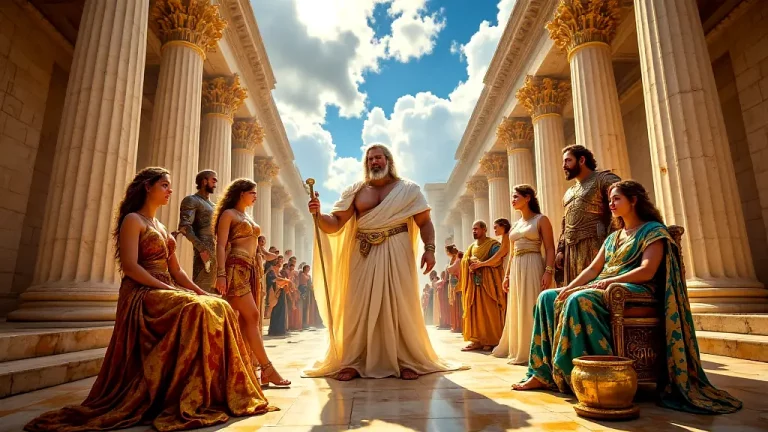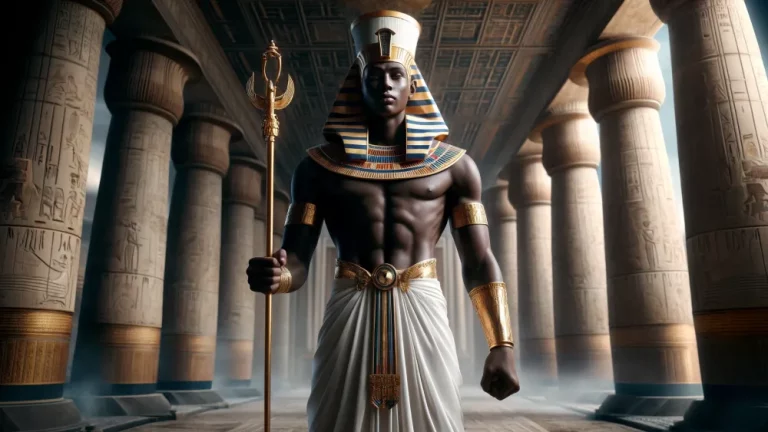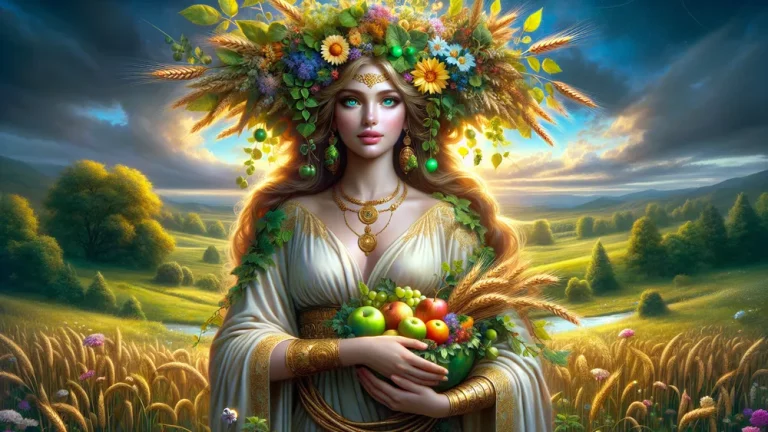What Is Calypso The Goddess Of In Greek Mythology?
Do you know the story of the nymph who kept Odysseus trapped for seven years? In Greek mythology, Calypso is a divine figure full of contradictions – both a savior and a jailer, a goddess with the loneliness of an outcast. Homer’s Odyssey tells us about her. She lives on Ogygia, a remote island that’s stunning yet strangely empty, as if time doesn’t move there.
Key Points:
- Calypso is a nymph, daughter of Atlas, who lives alone on the island Ogygia.
- She kept Odysseus trapped for seven years, offering him immortality but he refused.
- Her island looks beautiful but is a hidden prison where time seems to stand still.
- Unlike other sea gods, she doesn’t rule the ocean but controls her own isolated world.
- Zeus ordered her to free Odysseus, which she did, though she was sad to let him go.
- Later stories say she had children with Odysseus after he left, but Homer doesn’t mention this.
- She stands for loneliness and the struggle between gods and human desires.
But what does Calypso actually rule over? Is she a goddess of the ocean, solitude, or something harder to define? This piece examines her background (as the daughter of the Titan Atlas), her unclear status (is she an Oceanid nymph or a true goddess?), and her connection to wild nature and lost wisdom.
We’ll also explore her role in Odysseus’ journey, her powers (like the ability to grant immortality), and how later writers changed her story. Whether you’re new to myths or already love them, get ready to explore Calypso’s world, where gods and human desires clash.
What Is Calypso The Goddess Of: Overview and Key Facts
| Aspect | Details | Sources and Notes |
|---|---|---|
| Divine Status | She’s often called an Oceanid nymph (daughter of Titan Atlas and Oceanid Pleione), but Homer refers to her as a “goddess” (Odyssey 5.118). Later stories make this unclear. | Hesiod’s Theogony (nymph); Homer’s descriptions (goddess). |
| Domain | She ruled Ogygia, a faraway island. It stood for loneliness, secrets, and wild landscapes. It was a stunning place, but impossible to leave. | Odyssey 5.55-75 (island details); Hesiod connects Ogygia to the underworld in some texts. |
| Powers | – Could grant immortality (offered to Odysseus). <br> – Enchantment (trapped sailors with charm, not force). <br> – Herbal magic (used ambrosia and prophetic dreams). | Odyssey 5.135-136 (immortality); 7.259-260 (enchantment). |
| Role for Sailors | She had two sides: she saved sailors, but then kept them trapped. She attracted sailors with offers, not music. | Homer’s term “δεινὴ θεός” (dread goddess – 5.151) shows this double role. |
| Symbolism | She stands for lost places, the struggle between gods and human wishes, and the cost of eternal life (Odysseus refused her offer to go back to his aging family). | Scholarly works (e.g., Jenny Strauss Clay’s The Wrath of Athena). |
| Key Myths | Best known for holding Odysseus for seven years in The Odyssey. Other myths (like Telegony) say she had his sons after he left. | Telegony (lost epic, summarized by Proclus); Odyssey 5.14-268 (main story). |
Calypso’s Family and Origins
To grasp Calypso’s godly qualities, we need to examine her roots. Her family history shows us where she came from and what we learn about her powers.
Where She Came From and Her Nymph Nature
Calypso seems powerful because of her parents. Her father was Atlas, the Titan who held up the sky, and her mother was Pleione, a sea nymph. This made Calypso one of the Oceanid nymphs, a group of 3,000 divine beings who controlled rivers and springs.
Unlike other nymphs like the Nereids (who lived in the Mediterranean) or the Oreads (mountain nymphs), Oceanids were connected to freshwater places. They could be helpful but also dangerous. Calypso had famous siblings:
- The Pleiades: Nymphs who became the Seven Stars constellation
- The Hyades: Nymphs who brought rain and helped raise Dionysus
Hesiod’s Theogony (lines 346–370) calls Calypso a nymph. However, Homer’s Odyssey (5.118) describes her as a “goddess.” Scholars believe her Titan ancestry gave her powers beyond normal nymphs.
Calypso was stronger than most nymphs because her dad was the Titan Atlas and her mom was a sea nymph, giving her special powers.
What Was Calypso the Goddess Of?
Her divine family explains her power. However, what she controlled reveals even more about her unusual nature.
The Nymph Who Ruled Ogygia
Ogygia was more than Calypso’s home – it was her divine domain. She controlled this isolated island completely. Homer’s description (Odyssey 5.55-75) shows both its beauty and its purpose. The island had grapevines, fresh springs, and magical gardens. Yet it also served as a prison no one could escape. Calypso’s caves were large and contained purple looms. These showed her connection to secret knowledge and wild nature.
Some ancient texts, like Hesiod’s fragments, suggest Ogygia might have had underworld ties. This would make Calypso connected to both life and death. In this remote place, Calypso’s rule was absolute. She could keep shipwrecked sailors alive forever, but never let them depart. The island’s beauty hid its true nature as a place of endless confinement.
Her Complicated Role for Sailors
Shipwrecked sailors reaching Ogygia discovered Calypso’s contradictory nature. She helped survivors but never let them leave. Homer describes her as “δεινὴ θεός” (Odyssey 5.118), meaning “dread goddess”. This title shows she was both powerful and dangerous. Calypso famously cared for Odysseus after his shipwreck. She provided food, shelter, and even offered immortality. However, her help came with strict conditions – no one could depart.
This broke the Greek tradition of xenia, where hosts eventually let guests go. Ancient Greeks debated her motives. Some saw her as a lonely being who wanted company. Others believed she used hospitality to trap visitors. Like the sea near her island, Calypso’s true nature was hard to define. She remained both helpful and controlling to those who reached her shores.
Ogygia: Calypso’s Hidden Island
Ogygia reveals Calypso’s contradictory nature. This remote island functioned as both her domain and place of confinement. By studying it, we see how she could rule yet remain trapped herself.
The Island’s Look and Meaning
Ogygia combined beauty with confinement. Homer’s description (Odyssey 5.63-73) details its features:
- Eternal springs flowed into stone basins, showing time stood still
- Enchanted gardens grew violets and celery without care
- A vast cavern had high stone arches that provided shelter
- Poplar and cypress groves held singing birds that created calm
Later writers like Apollonius of Rhodes claimed the island could move or disappear. All accounts agree its physical appeal hid psychological traps. Sweet meadows made sailors forget home, while clear waters reflected only Calypso’s will. The cave’s purple looms (Odyssey 5.62) mattered too. This color represented royal power but also the sea’s changeable nature. Together, these elements made Ogygia appealing yet inescapable.
Calypso and Odysseus’ Famous Story
Ogygia was famous for its beauty, but its real importance came when King Odysseus arrived. After his shipwreck, the island became the setting for a significant encounter between a human and a goddess. This meeting between Odysseus and Calypso would become one of mythology’s most discussed relationships between mortal and divine.
How Odysseus Ended Up on Ogygia
Odysseus arrived at Ogygia in terrible condition. According to Homer (Odyssey 5.282-296), he barely held onto the broken pieces of his raft after a massive storm. This happened because he had angered Poseidon by blinding the cyclops Polyphemus (Odyssey, Book 9). The sea god convinced Zeus to send the storm that wrecked Odysseus’ boat. For nine days, Odysseus drifted at sea before reaching Calypso’s island.
Ancient listeners would understand this as standard punishment for humans who defied the gods. Homer describes how the waves smashed his raft completely (Odyssey 5.368). Athena helped prevent him from drowning just before he reached land. This event was particularly important in Odysseus’ journey. He had already survived Circe’s magic and his trip to the Underworld. Now he faced his most difficult captivity.
Later writers suggested different versions of how he reached Ogygia, but Homer’s account remains the most accepted.

Odysseus barely survived a huge storm sent by Poseidon and drifted for nine days before reaching Calypso’s island, showing how the gods punished those who defied them.
Odysseus’ Seven-Year Stay
Odysseus spent seven years on Ogygia (Odyssey 7.259). While Calypso provided many comforts, he remained her prisoner. She used various methods to make him forget Ithaca:
- Immortality offers: She promised to make him a god (Odyssey 5.136)
- Prophetic dreams: She sent visions suggesting his family no longer waited
- Herbal magic: She gave him ambrosia and other divine foods (Odyssey 5.93)
- Physical comforts: His cave had stone looms and purple robes (Odyssey 5.62)
Despite these luxuries, Odysseus remained miserable. Homer writes he often sat by the shore, weeping from longing for home (Odyssey 5.151-158). Unlike his time with Circe, where his crew changed form, here he kept his full awareness. Some later stories claim he had children with Calypso, but Homer focuses on his constant desire to return to Penelope. Calypso’s approach mixed kindness with control.
She would comfort him while ensuring he couldn’t leave. This made his captivity particularly difficult, as he received good treatment but remained trapped against his will.
The Gods Step In: Hermes’ Message
Zeus finally acted to resolve Odysseus‘ captivity (Odyssey 5.28-148). He sent Hermes, the gods’ messenger, to deliver a clear order to Calypso: release Odysseus immediately. Athena had repeatedly argued for this decision. Hermes traveled quickly to Ogygia, his golden sandals barely touching the ground. When he arrived, his caduceus staff shone brightly. He found Calypso singing while she worked at her loom.
The message from Zeus left no room for refusal. Although Calypso was a powerful nymph, she couldn’t disobey Zeus. Her angry response showed her frustration: “You are hard-hearted, you gods” (Odyssey 5.118). This demonstrated the strict order among the gods, where even strong immortals had to follow Olympus‘ rules. Some later versions claim Hermes needed to persuade Calypso, but Homer presents it as a direct command.
The event proved that no one, not even a divine being, could ignore the will of the chief gods forever. This marked the beginning of Odysseus’ journey home.
Calypso’s Sad Goodbye
When Calypso followed Zeus‘ command to release Odysseus (Odyssey 5.148-227), she showed emotions unusual for a divine being. Despite her power, she helped Odysseus prepare for his journey in practical ways. She gave him tools from her divine supplies and taught him how to navigate. “I cared for him and promised to make him immortal,” she lamented (Odyssey 5.136).

This revealed her sadness at losing him, even though she had to obey the higher gods. Homer presents Calypso differently than other divine characters. Instead of being angry, she appears complex and emotional. She provided Odysseus with food, drink, and cedar-scented clothing (Odyssey 5.264), showing she still felt affection. Later myths expanded this story, but Homer’s version remains the most detailed. It demonstrates that even powerful immortals had to accept the rules of the gods.
The scene also revealed that divine beings could experience human-like feelings of loss and resignation.
Calypso’s Abilities and Divine Traits
We saw Calypso‘s emotional goodbye. Now let’s look at her special abilities as a goddess in Greek mythology.
Her Power to Grant Immortality
Calypso could give immortality, a rare power among gods. She offered this to Odysseus to convince him to stay (Odyssey 5.135-136). Her promise included both eternal life and eternal youth, which even most deities couldn’t provide. Few beings had this ability. The goddess Eos gave her lover Tithonus eternal life, but forgot to include eternal youth.
While most nymphs could enchant mortals, only powerful beings like Calypso could grant true immortality. Homer doesn’t explain exactly how she would do this. Scholars believe she might have used divine substances like ambrosia. As the daughter of Atlas, she had abilities beyond normal nymphs, possibly from her Titan heritage. This shows a key lesson: immortality without eternal youth could be terrible.
Tithonus kept aging endlessly because Eos didn’t ask for both gifts. Calypso offered both eternal life and youth, proving how much she wanted Odysseus to stay. His decision to refuse was especially significant.
Calypso in Ancient Stories
Calypso had powerful abilities. But ancient writers described her in different ways across their works.
How Homer Portrayed Her
In the Odyssey, Homer shows Calypso as both powerful and emotional. She combines godly authority with very human reactions. Important scenes reveal her character. She angrily tells Hermes ‘You gods are always jealous!’ (Odyssey 5.118), yet gently helps Odysseus. Homer repeatedly calls her ‘the nymph with lovely braids’ but also ‘the dread goddess’, showing her dual nature.

While she initially resists Zeus’ orders, she eventually obeys. This makes her more complex than typical nymph characters. Homer does something unusual by making this goddess seem human. When she cries while building Odysseus’ raft (Odyssey 5.156-158), we see real emotion. Through her offer of immortality and these actions, Homer creates a deep character that goes beyond simple roles.
Calypso mixes godly power with human feelings, making her more complex than other mythical figures.
Later Writers’ Takes on Calypso
Later Greek writers created new stories about Calypso. The Telegony from the 6th century BCE says she had two sons with Odysseus – Latinus and Telegonus. This happened after he left her island. Hesiod’s Theogony (about 700 BCE) calls her one of the Oceanid nymphs (line 359). This differs from Homer’s version where her origin isn’t as clear. Other poets like Bacchylides saw her mainly as a dangerous temptress.

Some lost ancient poems say Calypso might have left Ogygia. This contradicts Homer’s description of her always grieving there. These different versions show writers couldn’t agree on her final fate. Later scholars even tried to find Ogygia on real maps. Many thought it could be near Malta. This proves Calypso’s story kept changing long after Homer wrote about her.
How Calypso Compares to Other Sea Gods
Calypso stands apart in Greek mythology. Here’s how she differs from other sea gods. The differences reveal what makes her special.
Side-by-Side Look at Greek Sea Deities
We can see Calypso’s special role by comparing her to other sea deities. Here’s how they differ:
| Deity | Classification | Domain | Special Abilities | Interaction with Mortals | Key Myth |
|---|---|---|---|---|---|
| Calypso | Oceanid Nymph | Ogygia | Immortality grants, prophetic dreams | Held Odysseus captive for 7 years | The Odyssey |
| Thetis | Nereid | Open sea | Shapeshifting, prophecy | Married mortal Peleus, mother of Achilles | Trojan War myths |
| Circe | Minor Goddess | Aeaea island | Transformation magic, herb lore | Turned Odysseus’ men to swine | The Odyssey |
| Nereids | Sea Nymphs (50) | Mediterranean | Calming waves, aiding sailors | Generally benevolent towards humans | Various sea myths |
Table sources: Homer’s Odyssey, Hesiod’s Theogony, and other ancient Greek texts Calypso stands out because she rules just one island but has strong magic. While Thetis and the Nereids represent typical sea powers, and Circe is also an enchantress, Calypso has a unique position. Each deity’s abilities match their realm. Calypso can give prophetic dreams, Thetis can change shape, and Circe can transform people.
This comparison shows why Calypso is neither fully nymph nor goddess, but something different.
FAQs
1. Is Calypso a goddess or a nymph?
Calypso is primarily a nymph (an Oceanid daughter of Atlas) though Homer’s epithets occasionally blur her status with goddess-like traits.
2. Why did Calypso imprison Odysseus?
Calypso imprisoned Odysseus out of love and longing for companionship, as described in Homer’s Odyssey.
3. How does Calypso differ from Circe?
Calypso differs from Circe in her use of herbal magic and eternal isolation on Ogygia, while Circe employs transformative potions and allows Odysseus to leave Aeaea after a year.
4. What happened to Calypso after Odysseus left?
After Odysseus left, Calypso faded from major myths, though later fragments like the Telegony suggest she eternally mourned his departure.







